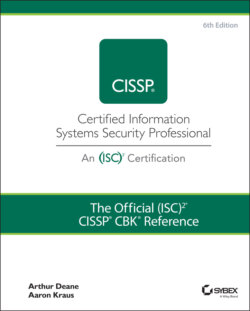Читать книгу The Official (ISC)2 CISSP CBK Reference - Leslie Fife, Aaron Kraus - Страница 153
STRIDE
ОглавлениеSTRIDE is a threat modeling methodology developed by Microsoft in the late 1990s to help identify and classify computer security threats. The name itself is a mnemonic for six categories of security threats, discussed here:
Spoofing: Spoofing is an attack during which a malicious party assumes the identity of another party (either a user or a system) by falsifying information. A common example of identity spoofing occurs when email spammers modify the “From:” field to depict the name of a sender that the target recipient is more likely to trust. Within applications, spoofing can occur if an attacker steals and uses a victim's authentication information (like username and password) to impersonate them within the application.
Tampering: Data tampering is an attack on the integrity of data by intentionally and maliciously manipulating data. Tampering can include altering data on disk, in memory, over the network, or elsewhere. Applications that don't properly validate user input may allow malicious actors to modify values and have the manipulated data stored and used by the application.
Repudiation: Repudiation is the ability of a party to deny that they are responsible for performing an action. The threat of repudiation occurs when a user claims that they did not perform an action, and no other party is able to prove otherwise. In the physical world, signing for a mail delivery is a common form of nonrepudiation — the delivery company maintains a record that you received and accepted the mail on a specific date. In the digital world, an example of a repudiation threat is a user claiming that they did not make an online purchase — even if they did, in fact, make that purchase. Comprehensive logging, digital signatures, and multifactor authentication can be integrated into applications to provide nonrepudiation for high-risk actions.
Information disclosure: Information disclosure is when information is shared with an unauthorized party — such as during a data breach or when inadvertently sending an email to the wrong person. This threat compromises the confidentiality of data and carries a great deal of risk depending on the sensitivity of the leaked data. Organizations that store and process PII, PHI, cardholder data, or other confidential information should focus on this threat, and identify controls to mitigate against it. Data encryption, strong access control, and other data protection mechanisms are the keys to protecting against unauthorized information disclosure.
Denial of service: A denial-of-service (DoS) attack is a common availability attack that denies access to resources by legitimate users. Controls should be put in place to monitor and detect abnormally high resource consumption by any single user; this may be an indication of either malicious or unintentional resource exhaustion. As a principle, applications should be developed with availability and reliability in mind.
Elevation of privilege: Elevation of privilege (or privilege escalation) occurs when an unprivileged user is able to upgrade their privileges to those of a privileged user (e.g., a system administrator). Elevation of privilege can give an untrusted party the “keys to the kingdom” and grant them access to and control over sensitive data and systems. Strong access control is required to help protect against this threat. Systems should revalidate a user's identity and credentials prior to granting privileged access, and multifactor authentication should be used, wherever possible.
